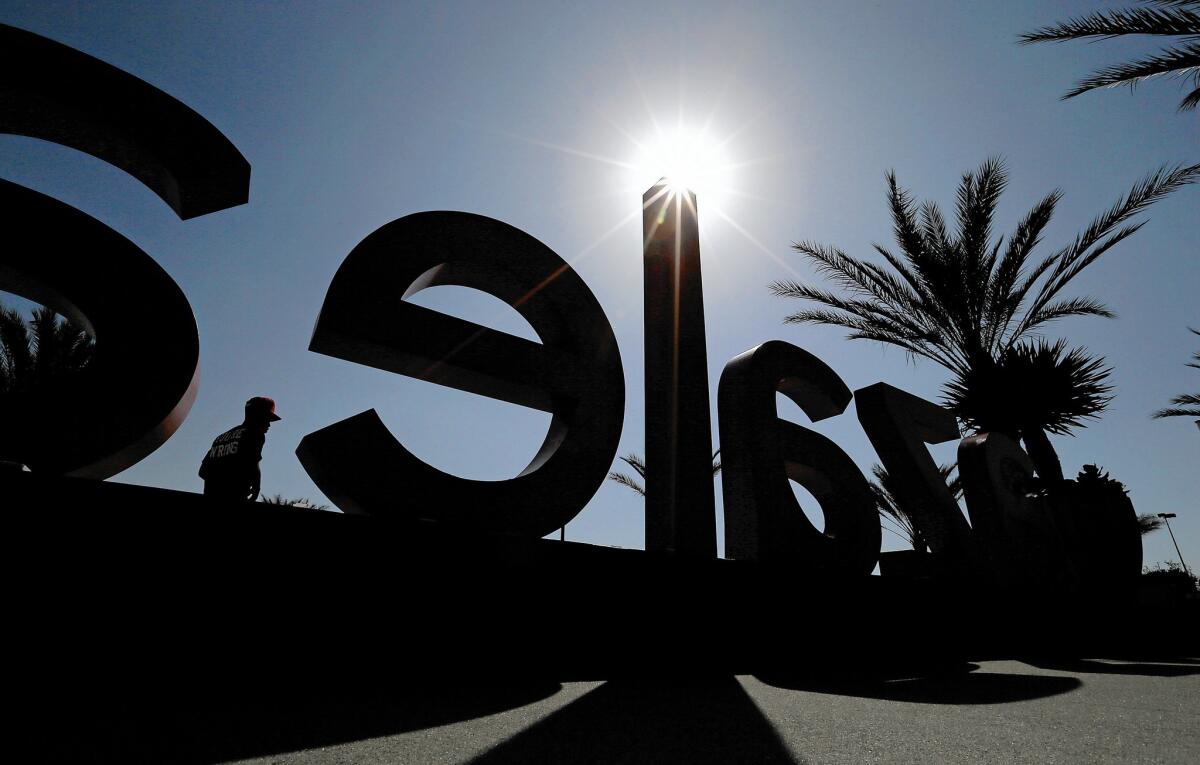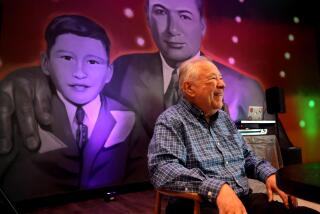Latino immigrants finally getting suburban-style chain stores

The Azalea shopping center features a lineup of shops familiar to suburban malls: Forever 21, TGI Friday’s and Michaels.
What makes the Azalea unusual — and, in the eyes of some, revolutionary — is that it’s in South Gate, in the heart of working-class southeast Los Angeles County.
The city is 95% Latino, and the year-old retail center is the region’s first made up entirely of mainstream American businesses. The closest thing to a Latin American business at Azalea is a Chipotle.
Residents living in the cluster of small, predominantly Latino cities along the industrial 710 Freeway corridor have long sought more shopping options. But attracting mainstream businesses has been difficult.
It wasn’t long ago that it was considered a coup for South Gate as well as neighboring Bell, Lynwood and Huntington Park to score a Starbucks.
“We couldn’t get national or regional brands to pay attention to the southeast, mostly because they didn’t understand it,” said Arturo Sneider, chief executive and cofounder of Primestor Development Inc., the firm behind Azalea. “There wasn’t enough of a corporate drive to market the strength and size of the Hispanic buying power nationally.”
But that is changing, along with the demographics.
Despite all the talk about illegal immigration in the 2016 presidential campaign, the vast majority of U.S. Latinos are native-born. The Latino population growth has been driven mainly by births, not immigration, since 2000, according to the Pew Research Center, a nonpartisan think tank.
Almost 70% of Latinos reported speaking English, and about 90% of U.S.-born Latinos — including small children of Latin American immigrants, who usually speak Spanish first — speak English, Pew reports.
Meanwhile, Latino median income is rising, according to the U.S. Census Bureau: From 2012 to 2013, it climbed 3.5%, to $40,963. And Latino purchasing power has increased by 50% since 2010, from $1 trillion to $1.5 trillion in 2015, according to Nielsen, a global marketing research firm.
This is persuading mainstream retailers to locate businesses in places like southeast L.A. County.
“The old model of catering to Spanish-speaking Latinos is fading and is being replaced by English-speaking Latinos who prefer mainstream retailers and restaurants,” said Luis Valenzuela, principal with Via Vista Advisors, a real estate consulting and brokerage firm.
In some Southern California cities, including Santa Ana and Baldwin Park, political tugs of war have broken out between mostly Latino council members and residents over attempts to replace retail stores that catered to immigrants with more mainstream shops, sometimes reflecting generational schisms within the largest minority group in the U.S.
In Baldwin Park, the Mexican American mayor in 2008 referred to developers’ instinct to bring in what he called “amigo stores” — his shorthand for immigrant-centric businesses. Meanwhile, some residents accused politicians of being ashamed of their roots.
In South Gate, the new shopping center coexists in a landscape that is peppered with businesses that seek to reach the large immigrant population in the region.
Across from the center is Rincon Taurino, a Mexican restaurant, and farther down is Hermandad Mexicana Nacional, which provides immigration services.
Jaime Garcia, director of marketing and events for the Azalea Regional Shopping Center, said it has hosted movie nights and music concerts geared toward both English- and Spanish-speaking Latinos.
“Each generation assimilates more and more without forgetting their roots,” Garcia said. “There is a bilingual element to our marketing as well as the entertainment we bring in. It’s not just mainstream.”
On a recent afternoon, Angel Sotelo, 51, a Mexican American resident from Bell, watched his grandson cool off by running through vertical water jets at the shopping center, which opened in August 2014. He said he welcomed shops that are typical of many American towns.
“Our kids grow up in a Latino home and speak Spanish, but when they go to school it’s all English, and their habits and trends [are] all Americanized,” he said. “Here you have American shops, you have diversity.”
Sotelo’s 19-year-old daughter, Amanda, said she rarely goes to stores and restaurants that target Latinos because “I already get so much of my culture at home through food and music.”
“Sometimes,” she said, “I just wanted something different.”
Officials for the 380,000-square-foot Azalea won’t provide numbers on revenue, but South Gate officials say it has generated $2.6 million in sales tax during its first year.
Primestor officials said they knocked on doors, held town hall meetings and did surveys to determine what type of shops Azalea should have.
“During the conceptualization of Azalea, public outreach — and the developer found the same thing — the residents wanted the building architecture, restaurants and stores that they saw elsewhere,” said Steve Lefever, South Gate’s director of community development. “They didn’t want to drive to Long Beach, downtown Los Angeles or Cerritos. They wanted it closer to home.”
By the early 2000s, national retailers were arriving in greater numbers in the cluster of cities in southeast L.A. County. One of the first major shopping centers with a significant number of such businesses was El Paseo, which opened in 2001 just east of Azalea, across the L.A. River and 710 Freeway.
With architectural touches modeled after a Maya temple and replicas of ancient stone snake heads spurting water into a fountain, El Paseo boasts the only large movie theater in the area. It attracted chains such as Starbucks, Panda Express and Fitness World, along with more immigrant-focused businesses such as La Mejor Deli and Market and Curacao, which houses a Pollo Campero, a fried chicken restaurant chain from Guatemala.
“Outside of that, we had nothing but small mom-and-pop shops,” South Gate Councilman Gil Hurtado said. “When the shopping center opened, it gave us something.”
Attracting some of the big retailers, including Starbucks, was a challenge.
Ken Lombard, an executive with Capri Capital Partners, who was formerly with Starbucks Entertainment, said the success of the coffee shop at El Paseo was a matter of looking beyond the research data, which he said did not fully account for a large chunk of the local population or the traffic flow in the area.
“We stood on the corner and watched to see how busy it was,” Lombard said. “Immediately, we knew it was a store we wanted to open, and we anticipated it would be successful.”
Soon after, Plaza Mexico opened in Lynwood, as developer Donald Chae noted the emergence of the Latino population in the formerly black-majority city.
His shopping center was designed around replicas of Mexican landmarks, including Mexico City’s Angel of Independence. The center housed organizations representing various Mexican states, but it struggled for years to attract major U.S. retailers, apart from Ross, Chuck E. Cheese’s and a Food 4 Less supermarket.
The initial success of Azalea has helped inspire South Gate officials to look at redeveloping Tweedy Boulevard, a long corridor of small businesses that has seen better days. They say residents want the type of shops found in hip areas of L.A. such as Silver Lake and Los Feliz.
“The community is so hungry for this kind of stuff,” South Gate Mayor Jorge Morales said. “We’re American too, we appreciate the culture and think the same.”
Twitter: @latvives
ALSO:
Why L.A.’s homeless camp cleanups seem to be futile
Flood-prone Newport Beach is getting ready for El Niño
Immigration agents allowed back in L.A. County jails, with limits
More to Read
Sign up for Essential California
The most important California stories and recommendations in your inbox every morning.
You may occasionally receive promotional content from the Los Angeles Times.











